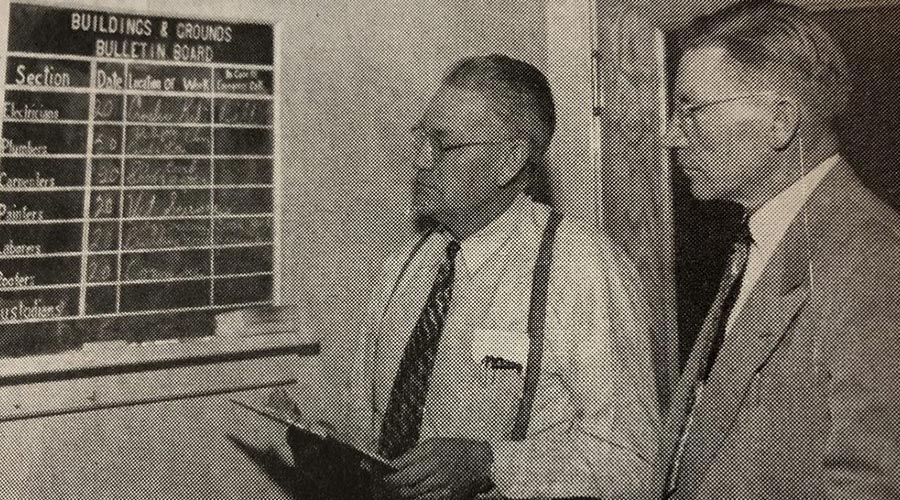Ready for Prime Time?
Incentives and improved technology have given solar power a big lead over fuel cells on the road to widespread acceptance
Photovoltaic cells and fuel cells take very different routes to reach the same end: offering facility executives renewable sources for onsite power. Photovoltaic cells or PVs look like opaque windows that silently, almost magically, create electricity. With a fuel cell, there’s a palpable sense that it is doing something machine-like, churning out electrons with a busy, quiet hum.
Perhaps the most important difference between PVs and fuel cells, however, is market acceptance. There’s every indication that PVs are ready to make a big impact in the onsite generation market. They are cost effective today for some markets and applications and are approaching mainstream use in possibly five to 10 years. Fuel cells, despite their potential, face technological and cost hurdles that may take 10 to 15 years to overcome.
Turning the Corner
PVs, many experts say, are following the path of computer technology. Like computers, PVs started as an expensive niche product that manufacturers reworked continuously to reduce production costs and improve performance. Now with the quality up and price down, supplies are increasing, putting PVs at a tipping point.
“The U.S. solar electric market has turned the corner,” says Niels Wolter, solar technology leader for Wisconsin’s Focus on Energy program. Wolter is projecting significantly lower prices for systems in the near future that will capture the mainstream’s interest.

Noah Kaye, director of public affairs for the Solar Energy Industry Association (SEIA), agrees the near-future looks bright. “We expect to see a tripling of supply (of PV modules) in 10 years, cutting costs in half.” PV modules typically comprise about half the cost of an installed PV system. Similar cost cuts are expected for other PV system components as well.
Without incentives, PVs presently cost about $0.20 to $0.30 per kilowatt-hour over the 30-year life of a system. Utility costs are between $0.08 and $0.10 per kilowatt-hour. SEIA predicts that solar cost could drop to $0.12 in five years. If a long-term energy policy friendly to renewable sources emerges from the new Congress, PV power could rival utility grid power on price in most locations in no more than 10 years.
First costs are about $6 to $8 per watt for an installed commercial PV system, depending on the size of the system. Without incentives, the payback is too small for most facility executives to even recognize it as a payback. Experts say that once installed costs drop to $3 per watt, PVs then become cost competitive with utility power.
All this emphasis on supply is a result of increasing demand and investment interest. According to the U.S. Department of Energy’s Energy Information Administration (EIA), domestic shipments in the United States have increased by more than 40 percent in the last two years — even faster than demand worldwide at 20 to 30 percent. Among the market sectors, the commercial market remained the largest sector for PV shipments. The United States also is attracting foreign investment in new manufacturing facilities. Wall Street is responding positively to new and existing PV companies.
All this success has created a temporary problem: Demand has been so high globally that prices on PVs the last two years have gone up. The most recent data, however, suggest that prices have stabilized and all indications are that they are going to start going down. The price rise and fall reflects a convergence of efforts that all have to do with one thing: silicon.
More With Less
The most important components of a PV cell are two layers of semiconductor material that, for about three-quarters of PVs made, is composed of silicon crystals. Not a particularly good electrical conductor, silicon is amended or doped with other materials to increase its conductivity and create positive and negative charges. It is then formed into wafers and assembled into cells.
When sunlight enters the cell, photons knock loose electrons. The electrons travel from the negative side to the positive side. Thin wires along the negative side provide the pathway for these electrons, creating current.
But it all starts with silicon, which is also a key ingredient in computer chips. The increased demand for PVs has created a shortage of silicon the last few years. The shortage has been driving up the cost of PVs and creating a supply bottleneck.
Three things are happening simultaneously to address this problem. New manufacturing facilities to produce the silicon for silicon wafers will soon come online, some as early as next year. In addition, PV cell manufacturers are fine-tuning manufacturing processes to make wafers thinner, using less silicon while increasing efficiency. Finally, manufacturers are turning to other ways of manufacturing PVs, such as so-called thin films.

Thin-film technology doesn’t require a rigid substrate like other PV modules. Some use a very thin layer of a different kind of silicon called amorphous silicon that can be applied to a flexible substrate. A quicker manufacturing process and the reduction in materials makes this thin-film technology less expensive to produce.
Thin-film technology isn’t necessarily tied to silicon. Two different manufacturing processes — one using cadmium telluride, the other based on copper, indium and selenium (CIS) films — are showing increasing promise in terms of lower costs and higher efficiency.
The efficiency of thin-film technology — its ability to convert sunlight to electricity — has been less than half that of rigid PV cells. The typical crystalline silicon PV cell is about 16 to 18 percent efficient, although lab prototypes have been developed to be 40 percent efficient. Current thin films are only about 6 percent efficient. However, besides being less expensive, new thin-film technology is increasing efficiency significantly. Installed cost for thin film is about $4 per watt.
Fuel Cell Power
Fuel cells have not garnered as much interest as PVs have outside of government and university laboratories. A major reason is the hydrogen fuel for fuel cells.
Fuel cells use a chemical process to break hydrogen down and in the process release electrons. This electrochemical process takes place between two electrodes — an anode or negative side and a cathode or positive side — with the help of an electrolyte. This combination forms the basis of a stack. Any number of stacks makes up the fuel cell. The design is essentially the same as a battery.
Rather than store energy like a battery, however, fuel cells make energy. Fuel, such as hydrogen, is pumped into the anode side and air is fed into the cathode side. It’s a reverse hydrolysis process: Instead of breaking water apart to get hydrogen and oxygen, hydrogen is combined with oxygen to produce water and in the process, electricity. The systems are 50 to 60 percent efficient. If steam generated by the reaction is used, fuel cells can be 80 percent efficient.
Hydrogen in many ways is an ideal fuel for fuel cells, providing electricity and emitting only water. But it doesn’t exist by itself in nature so it must be produced, adding cost and creating other problems. Some fuel cells, such as solid oxide fuel cells, can use “impure” forms of hydrogen such as natural gas or methane. This, however, creates other design and efficiency challenges for solid oxide cells. On top of this, hydrogen is difficult to transport and store at normal atmospheric pressure.
There are other problems as well. Because of the high temperature at which fuel cells operate, materials used are put under great stress and often don’t last long. Plus, the materials are expensive. And, ultimately, fuel cells are still using fossil fuels. All this diminishes their promise for any near-term onsite power solution, says Mark Daugherty, a renewable energy consultant and former CEO of Virent Energy Systems.
In 10 years, the United States may begin to see general commercialization of fuel cells if infrastructure problems with hydrogen and material engineering problems can be solved. But that is a big “if,” Daugherty says. Still, he says, fuel cells that operate in tandem with other renewable technologies to break water into hydrogen and oxygen hold promise for the future.
Making It Pay
As an onsite power supply, fuel cells would need to have an installed cost of about $1.50 or less per watt to be practical. Currently the cost is $4 or more. As with PVs, there are efforts to find less expensive materials and make the manufacturing process more efficient, but progress is slow. Yet there is progress. General Electric Co., in cooperation with a U.S. Department of Energy program, has produced a prototype solid oxide fuel cell that is estimated to cost about $724 per kilowatt to install and is 41 percent efficient.

One reason that fuel cells have been slower to gain market acceptance than PVs is that there are fewer incentives.
One incentive that does benefit both is the federal government’s Production Tax Credit (PTC), which has been extended through Dec. 31, 2008. That Congress extended this credit 13 months before it was set to expire suggests Congress’ interest in renewable onsite generation of power.
The PTC provides a 30 percent tax credit for fuel-cell power plants, solar-energy systems and even fiber-optics, if the latter is used to illuminate the inside of a facility. There is no maximum limit to the credit for the commercial market.
The federal government also offers the Federal Modified Accelerated Cost-Recovery System where businesses can recover investments in solar, wind and geothermal systems through an accelerated five-year depreciation schedule.
The states are taking the lead in encouraging the installation of renewable energy systems. While many states do offer incentives for fuel cells, they aren’t significant enough to offset costs. Yet half the states, which account for 70 percent of the country’s ratepayers, have incentives that help make PVs cost effective, says Scott Sklar, president of the Stella Group. According to the Database of State Incentives for Renewables & Efficiency, 18 states have numerous financial options, many of which can be bundled. While Sunbelt states seem to do well in this area, support for PVs isn’t restricted to one part of the country. Oregon, Massachusetts, New York, Rhode Island, New Jersey, Connecticut, Iowa, Ohio and Wisconsin all have good incentive programs that include additional tax credits, rebates, grants and loans. California leads them all.
When facility executives take advantage of federal credits and depreciation allowance alone, they can pay for about half the system, Sklar says. “In states with system benefit trust funds, renewable energy portfolio standards, credits and waivers, another 15 to 25 percent of the cost can be absorbed,” he says. “So basically these systems pay back in five years and can be made cash positive.”

PV systems also are saving commercial facility executives money and providing power quality, back-up power reliability and off-setting uniquely high electric rates, such as demand charges, peak power rates and ratchet rates. Sklar says that this market is huge and “is absolutely cost effective right now.”
Dealing With First Costs
Another way facility executives can make PVs cost effective is with building-integrated PV systems (BIPV). When PVs are integrated into elements of the building structure such as the curtainwall or roof, they can replace the cost of some building materials and provide high quality power. Even though the PV efficiencies might not be there, says Brad Pease, green building consultant for Paladino and Company, some facilities, such as some big-box retailers, can justify BIPV, especially roof systems.
There are other ways to approach PV systems today that take the cost burden from facility executives. They involve ESCOs and other third party investors in the system. Under these systems, facility executives agree to give the space, usually the roof top, to another company to pay for the installation of the PV system. The installer owns the system and takes all the available credits, depreciations and rebates. The facility executive agrees to buy the PV power at a rate agreed upon between the two parties — usually at a rate at or below the current utility rate. According to Jerry Yudelson, principal of Yudelson Associates, these arrangements work well with facilities of at least 100,000 square feet of rooftop area, good access to sunlight and lots of electrical demand.
For PVs, the solar decade has begun, Wolter says. For innovators and those with special power needs, there are plenty of opportunities now for PVs. The economic interest in pursuing PVs will only get stronger in the years to come because of higher utility rates, better incentives, carbon trading opportunities and lower system costs.
“While PV is scaling up manufacturing and new materials and processes are entering the market, prices will fall as they have for computers,” Sklar says. “So prices will decrease, but for some, waiting doesn’t make sense. Should I not have bought a $5,000 laptop in 1985 to wait for a $1,500 laptop in 2006?”
Comparison of Current
Onsite Electric Generating Costs
COMBINED CYCLE GENERATING TURBINE 3-5 CENTS PER KWH
| Wind |
4-7 cents
|
| |
|
| Biomass |
7-9 cents
|
| |
|
| Remote Diesel |
20-40 cents
|
| |
|
| Solar PV central utility |
20-30 cents
|
| |
|
| Solar PV distributed |
20-50 cents
|
|
VALUE ADDED
Are PV Buildings Worth More?
While there is no hard data yet to prove that PVs or any reliable, renewable onsite power generation increases the value of a building, many experts think it is only a matter of time before the evidence surfaces.
Scott Sklar, president of the Stella Group, says corporations have begun to BRAND THEMSELVES GREEN for customer retention and market differentiation. The Durst family, owners of 4 Times Square in New York City, used that PV-powered building to show that building owners can attract tenants at full rental rates and can LEASE THE SPACE FASTER THAN SIMILAR BUILDINGS.
“It’s still new territory, but I actually think that having buildings that are surge-free, outage-free, and limited in electric and gas rate increases does have A MARKET VALUE,” Sklar says.
|
David Kozlowski is a freelance writer and former senior editor of Building Operating Management.
Related Topics:















